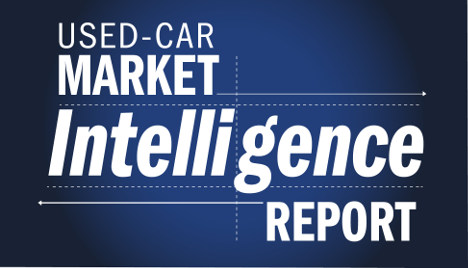Group 1 Automotive’s overall second-quarter figures show a 3.6-percent year-over-year rise in used-vehicle sales and a 6.4-percent lift in new models retailed. But the unusual path company stores in various markets took to those top-line performances is what left president and chief executive officer Earl Hesterberg wondering what happened.
Hesterberg described the used-vehicle market overall as “a little bit softer” in Q2. Investment analysts asked him to elaborate during Group 1’s conference call on Thursday.
“I couldn’t tell you exactly why,” Hesterberg began. “Although in June, I had the impression that there was a lot of new-vehicle volume pressure from a variety of OEMs to hit targets and things, and perhaps new cars sat down on used cars a bit.
“In our case, we had a big variation — the biggest variation I have seen in a long time — among performance from various geographies,” he continued. “And much of our weakness was driven by an actual 20-percent decrease in used-car sales in New Jersey and New York. We also had a couple of markets that were flat.
“Generally, our used-car performance was much better than our total corporate metric would indicate,” Hesterberg went on to say. “So we were depressed a bit by a couple of poor performances in specific geographies, and the same was true on new vehicles. We had a little bigger variation than I'd seen before.”
On the new-vehicle side, Hesterberg pointed out what Group 1 considers to be its core markets — south Texas, California and the Gulf Coast — produced a new-model increase of almost 9 percent.
“We were flat for the first time in the Atlantic Coast, and we were very weak in New Orleans. So we had a huge spread,” Hesterberg said.
Impact of Recalls on Service Drive
With General Motors alone recalling more than 26 million vehicles in the U.S. so far this year, Hesterberg fielded inquiries on whether this repair work boosted the company’s service drive and its performance in that segment. Group 1 reported an 8.8-percent jump in revenue from its service department in the second quarter compared to a year ago.
While the company wants to grow its service department, it’s not expecting that upward movement to come solely because of automaker safety recalls.
“Parts aren't available in many cases, or not sufficient parts,” Hesterberg said. “But for the last year or so, I think it's fair to say that our overall business has had a positive effect from a variety of recalls, but probably not the ones that you're thinking of or that you’ve heard the most about recently.”
And Hesterberg doesn’t expect a flood of Chevrolet Cobalts to arrive for repair. The Cobalt is among the models included in the high-profile ignition recall that’s gotten GM plenty of attention from the National Highway Traffic Administration and lawmakers on Capitol Hill.
“I have to tell you, I don’t think we have as much traffic in the dealerships yet on these old model recalls as you might expect us to,” Hesterberg said. “And I’m not sure yet how many of these customers are going to come in. So we'll have to wait and see about that. Some of these cars are very, very old. In my experience, you get a very low return rate on some of these very old cars.”
If in fact a large amount of recall work ends up at Group 1 dealerships, Hesterberg insisted the company stores have plenty of capacity in terms of bays and infrastructure to handle it. But like other public dealer groups such as AutoNation and Asbury Automotive Group shared in this Auto Remarketing report, Group 1 also is struggling to have enough personnel to complete the work.
“I have to tell you we always struggle with technicians. We could use more technicians, and we’ve been trying to increase our human capacity for quite some time,” Hesterberg said. “We have the physical plant necessary, but we’re going to continue to drive to increase the number of technicians we have.”
For both dealers and finance companies, the cost of being compliant is on the rise. Recent reports and reprimands are giving concrete financial figures to what making installment loans attached to vehicles entails nowadays.
Before getting into those numbers, Rick Hackett touched on the reason why compliance is such an important — and consequently costly — part of doing business. Hackett spent about two years at the Consumer Financial Protection Bureau before returning to private practice by joining Hudson Cook in March.
Hackett’s responsibilities at the bureau included advising all of the regulator's divisions with respect to market information and policy issues in the installment and specialty lending areas, including vehicle finance, student lending and payday lending
Hackett described the “long, evolving process” that’s unfolding in indirect auto lending.
“It’s the first time you’ve had a federal regulator focused on the finance space strictly in consumer and with concern only for consumer protection, not for other sometimes conflicting issues like safety and soundness,” Hackett said. “The federal financial regulators have done a lot of work on consumer protection but they also have a bunch of other hats to wear. The Federal Trade Commission has done some great work in consumer protection, but they have many markets other than consumer finance to deal with.
“I think there will be growing pains for quite some time as the industry gets used to dealing with a regulator that’s solely focused on consumer finance and no other hats to wear. That’s just what Dodd-Frank said should happen. I think that also explains why so many people would like it to go away,” he went on to say.
“But over time, I think the bureau’s focus on getting everyone to have an appropriate compliance management system, appropriate to their size and complexity, if lenders spend the resources and bandwidth on compliance, they’ll find that’s it not more complex than making sure your mechanics can deal with whatever vehicles they have to work on,” Hackett added.
Dealer Cost for Compliance
And how much resources are dealing expending on compliance? Here are they numbers showing just how much of a bite regulatory compliance is taking out of franchised dealers’ profitability apple — especially for what it takes to legally operate the F&I office.
A new report released by the Center for Automotive Research in May showed U.S. franchised dealers spent $3.2 billion in 2012 to comply with 61 major federal rules, resulting in higher prices for dealership customers and the loss of an estimated 10,500 dealership jobs.
According to the report titled, “The Impact of Federal Regulations on Franchised Automobile Dealerships,” the average dealership incurred $182,754 in costs to comply with federal mandates governing employment, business operations, vehicle financing, sales, marketing and vehicle repair and maintenance. These regulatory costs equated to 21.7 percent of the average dealership’s pretax net profits — or about $2,400 per dealership employee.
The National Automobile Dealers Association commissioned the report produced by CAR, which is based in Ann Arbor, Mich. Analysts indicated cost estimates are for 2012 and are based on interviews in 2013 and 2014.
“The additional cost for new-car dealerships to comply with federal regulations are passed along to our customers in the form of higher prices, which results in lower vehicle sales and reduced employment at dealerships,” said Forrest McConnell, III, NADA chairman and a Honda/Acura dealer in Montgomery, Ala.
Drilling deeper into the report uncovered just how much F&I compliance is costing dealerships. Analysis of the mean values of compliance costs revealed that the dealership financial burden is greatest for the regulations included in the vehicle financing category, which includes items such as compliance with the Equal Credit Opportunity Act, the Fair Credit Reporting Act and the Truth in Lending Act.
In fact, more than 37 percent of that average cost increase stemmed from the necessities of compliance with federal rules involving the F&I office.
“It can be challenging for dealers to identify all costs associated with federal regulatory compliance. Some activities are spread among many facets of the business and accounting conventions do not support simple cost analysis. Other cost centers represent activities the dealers themselves admit they would do even if not regulated to do so,” the report said. “However, the data are clear that federal regulatory compliance costs are present and meaningful at all levels of the dealerships’ organizations.”
CPS Fined by FTC
Meanwhile, the cost of not being compliant with federal regulations can be steep, too.
The Federal Trade Commission said that Consumer Portfolio Services will pay more than $5.5 million to settle charges that the subprime auto finance company used “illegal tactics” to service and collect consumers’ loans, including collecting money consumers did not owe, harassing consumers and third parties, and disclosing debts to friends, family and employers.
According to regulators, CPS agreed to refund or adjust 128,000 consumers’ accounts constituting more than $3.5 million and forebear collections on an additional 35,000 accounts to settle charges the company violated the FTC Act.
The FTC also indicated CPS will pay another $2 million in civil penalties to settle FTC charges that the company violated the Fair Debt Collection Practices Act (FDCPA) and the Fair Credit Reporting Act (FCRA)’s Furnisher Rule.
The order settling the charges requires CPS to change its business practices to comply with the requirements of the appropriate laws. In addition, the company is required to establish and maintain a comprehensive data integrity program to ensure the accuracy, integrity and completeness of its loan servicing processes, and the data and other information it services, collects or sells.
CPS must also provide the FTC with periodic independent assessments of its data integrity program for 10 years.
CPS president and chief executive officer Brad Bradley issued a statement after the final settlement with the FTC was announced in May.
“We are pleased to have resolved the matter with the FTC,” Bradley said. “We cooperated fully with the FTC during their inquiry and made several system and procedural changes related to their comments. Furthermore, we are pleased that the final settlement is consistent with our expectations.”
Editor's Note: This story is part of the annual Used-Car Market Intelligence Report included in the July 1 print and digital editions of Auto Remarketing. To see the complete report — which includes analyses of digital marketing trends, leasing, dealership employee turnover and more — check out the digital edition that was published Tuesday morning.
Skip-tracing and forwarding company A. Smith Enterprises recently selected Vendor Transparency Solutions as an online compliance monitoring platform.
Because of the importance of detailed compliance, A. Smith Enterprises chose VTS since the firm offers a platform to serve present and future needs of the industry.
A. Smith Enterprises pointed out that VTS works for the protection and benefit of its partners, which include auto lenders, banks, credit unions, insurance companies, investor groups and many other types of businesses that are looking to minimize losses and maximize recoveries on their delinquent consumer and commercial collateral and non-collateral loans
“Compliance with the Consumer Financial Protection Bureau and proper vetting of your company and its partners are no longer optional,” A. Smith Enterprises operations manager Alan Lollis said.
“A. Smith Enterprises recognizes both the need and importance of making sure that its client Partners are protected,” Lollis continued. “A. Smith Enterprises makes it a point to ensure that they are doing all that they can to prevent mitigating loss, and significantly lower risks for its clients. This partnership makes it much easier through technology to monitor compliance.”
Vendor Transparency Solutions president Max Pineiro also commented on being selected by A. Smith Enterprises.
“We are at an age where maintaining the highest level of compliance and risk management should be the highest priority to all companies servicing financial institutions,” Pineiro said. “We are proud that A. Smith Enterprises has selected the most comprehensive platform available in the industry as their choice for compliance monitoring.”
In an effort to sharpen the debt-collection process, ACA International’s research department dissected 14,328 complaints received by the Consumer Financial Protection Bureau during a nine-month span and found five similar conclusions to a previous endeavor conducted last November.
The latest analysis stemmed from data collected between July of last year and February of this year and released by the CFPB, including product, sub-product, issue, complaint submission date and response timeliness.
ACA International determined:
—The average balance of accounts in third-party debt collection increased from $1,458 in the third quarter of 2013 to $1,520 in the fourth quarter of 2013, representing a 4.29 percent increase.
—The highest number of identifiable complaints was for credit card and medical debts. However, taking into account the category "others" and "not specified" together, 50.41 percent of the complaints were not associated with a particular debt collection product.
—The most reported consumer concern was being contacted about “a debt they did not believe they owed.” In second place was “communication tactics” followed by “disclosure verification of a debt.”
—Almost all the complaints received by the CFPB were responded to in a timely fashion. Based on the data, 96 percent of the complaints were responded to with a timely response.
—Of the 14,328 complaints analyzed, 94 percent were “closed,” “closed with nonmonetary relief” or “closed with explanation.”
While officials contend the CFPB complaint resolution process is a step in the right direction compared to other federal consumer complaint repositories, ACA International offered the following suggestions to the CFPB to improve the complaint database:
—Clearly identify first-party collections from third-party collections to ensure accuracy in complaint reporting and avoid the potential for double counting.
—Maintain context by resisting the temptation to use a broad-brush to paint debt collectors negatively or make assumptions about the behavior of an entire industry solely on top line volume data.
—Provide more consumer detail to debt collectors who are the subject of a complaint to increase the likelihood of more easily identifying the information needed to resolve the consumer’s complaint.
—Adopt a definition of a complaint that is limited to consumer allegations of wrongful conduct and does not include the amorphous concept of general consumer dissatisfaction outside of wrongful conduct.
ACA International said it plans to analyze this data on a quarterly basis and keep members informed of the findings.






